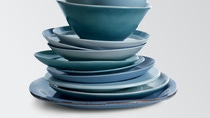Média
How do tabs make dishes shine?
Dishwashers make life easier, that’s for sure – but without the right dishwashing tabs, dishes would still be pretty grimy after the final rinse. So how exactly does one small tab manage to get dirty dishes, cups and glasses sparkling clean?

People expect a lot from dishwashing tabs: spotless dishes, gentle action, limescale prevention – and effective at low temperatures as well. To do all this, a variety of finely tuned interactive components are needed: surfactants to make grease soluble in water; enzymes to break down chain molecules like starch from flour and potatoes and proteins from meat and dairy products into their constituents ready for rinsing from plates and pots; and bleaching agents to remove tea and coffee stains.
About half of a conventional all-in-one tab consists of phosphates. Among other things, phosphates prevent the buildup of unsightly, white limescale marks by binding the responsible calcium and magnesium ions in the dishwater. Ecologically, though, phosphates have a bad reputation. As phosphorus is important in plant nutrition, phosphates can cause algal bloom in aquatic systems. The plants use up the oxygen in the water and may bring lakes and rivers to “tipping point.” This problem has already been tackled through the introduction of stricter phosphate limits for detergents and modifications in sewage treatment plants. Tougher regulations are likely to come. The expectation is that phosphate will be banned as an ingredient in dishwashing tabs in Europe starting in 2017. Such a ban has already been in force in 16 US states since 2010.
A more ecological alternative with undiminished tab performance was needed. BASF stepped in to meet the need with a readily biodegradable chelating agent called Trilon® M. In combination with polymers and other excipients, the agent binds the water hardness ions (Ca2+ and Mg2+) responsible for leaving chalky deposits on dishes and also removes persistent tea and coffee stains. Chelating agents literally “get to grips” with their target ions, and that is where the name comes from: “Chele” is Greek and means “pincers”.